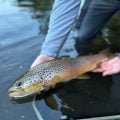When The Hatch Is Over
Have a question you want answered? Email it to us at ask@midcurrent.com.

Evening caddis. Photo Tim Romano
Question: What do you do when you’re fishing a hatch (BWOs, caddis, etc.) and then it’s over—the bugs stop appearing and the fish stop rising? Is it time to pack up and go home, or are there ways to keep catching those fish after the hatch has ended?
Bob J., Salt Lake City, UT
Answer: This is a tough one. If I have caught a bunch of fish, I usually don’t mind quitting when the fish stop rising. When I was a guide, the end of a hatch was a natural time to take a break or move to a new piece of water.
But in those situations when I did want to continue catching fish, my default tactic was dead-drifting a small Woolly Bugger under an indicator. It seems that fish that have recently been on the feed can’t resist a big hunk of meat.
Here’s what our panel of experts has to say on the subject:
Tom Rosenbauer, host of the Orvis Fly Fishing Guide Podcast:
I always find that I can pick off a few fish after a dun emergence on a fully-hackled fly, such as a variant, fished in faster water. For instance, if a cream colored fly in size 16 was hatching, I’ll fish a Cream Variant in size 16. This seems to work better in pocket or riffled water, where the fish that were feeding on the hatch may not have gotten as many bugs as the fish in the slower pools—plus it’s harder to prospect in slower water.
It’s also a good idea to look for places where drowned or crippled flies collect after the hatch. You may have to do quite a bit of walking, but with close observation it’s often possible to find places where drowned flies collect, usually in slow side eddies or whirlpools. These places should not be dead water—they have to have some current and are usually found just off the main flow. Fish taking these drowned flies will be very subtle risers because they know the flies aren’t going anywhere, so it pays to really stare at the water and get pretty close to the spots. In these cases, a fly that rides in the surface film, such as an emerger or a cripple, is a far better choice. I don’t distinguish between emergers and cripples because I think these two stages look similar enough that one pattern will do it.
Another tactic is to swing a soft hackle or winged wet fly after the hatch, especially if it was an evening hatch or spinner fall. I think this imitates drowned flies that didn’t emerge and are still drifting down, and sometimes it probably imitates adults that swim underwater to lay their eggs after a mating flight. Plus it’s easier to cover more water with a swung fly, and if it’s after dark it is easier to know if you get a strike. I think the fish notice a swung fly more against the skylight than a deep, dead-drifted fly.
Jim Bartschi, president of Scott Fly Rods:
If I’ve come to fish a specific hatch, I’ll try to time my arrival and departure with the start and end of the hatch. In those cases, I’ve got a goal in mind, say, fish the PMD hatch, and I’m happy to pack up and head home after accomplishing that.
If I’m just out fishing for the day and bump into a hatch, I’ll usually fish “past” the hatch and continue to target the fish. In those cases, a very effective technique is to fish drowned duns and cripples using your favorite nymphing setup. Often, fish will continue to feed subsurface and pick up the leftovers in the aftermath of a hatch.
Steve Hemkens, head of fly-fishing product development for Orvis:
Depends on the time of day…
If fish are still rising but it gets too dark to see the dry, which happens a lot during an evening caddis hatch, I’ll tie on a Soft Hackle or a fly that fish like to crush when it’s swung, such as a Crackleback or Vermont Caddis, and fish blind. If it’s late and getting toward dark, I’ll tie on a streamer and fish my way back up or down to the truck. Big browns are predominantly nocturnal and don’t tend to mess with that little stuff anyway, so fishing a sculpin, crayfish, or baitfish pattern can produce the fish of the year this way.
If it’s a midday hatch, like PMDs or BWOs, and the fish stop rising and I still have a lot of time to fish, I’ll go back to nymphing and try to use a pattern similar to what’s been happening. I’m not an aquatic biologist, but one thing I know is that there are always lazy fish, and even when it seems like every fish in the river is rising, that’s never the case. There are the fish that like to stay down in the water column and eat nymphs, and then there are the fish that like to rise. So tying on a nymphal version of whatever the fish were rising to usually nails a few after the surface activity has subsided. Fishing a flashy attractor pattern, like a Lightning Bug or a Copper John, can work great, too.
Bryan Gregson, professional fish bum, water-rights activist, and blogger:
Fishing drowned adult patterns can be very effective after the hatch is over. The fish are always still feeding. Evenings, I’ll toss on a streamer or perhaps a cricket or a mouse on the way back to the truck, and often I’ll scratch out a few on chance blind-casting. Many times, the fish are still looking up, and they just need a bit of motivation. But then again, more often than not, I’m actually content when the hatch is over. A few fat, sassy fish to hand is more than I need to have a great day on the water.
Matt Supinski, Great Lakes guide and owner of Gray Drake Lodge:
The hatch—that is, the visible part of it: emergence, floating airborne adults, egg-laying, spent spinners—is just the tip of the iceberg. Biological drifts of nymphs, pupae, stillborns, etc. happen before, during, and after the hatch’s visual and active surface feeding spectacle. Trout are junkyard dogs when it comes to feeding, and they will linger around the slop wagon of bugs long after the hatch is over.
Fish dead-drifting and moving/twitching nymphs, pupae, sunken spinners, and even imitations of nymphal/pupal skeletal cases and shucks. They eat this garbage too!
Trout always want one more bite, and they will be aggressive and active untill the next emergence. The only time satiation comes into play is when the hatch was too dense, and ingestion by the trout was to a total stomach-filling capacity, which really is quite rare. Only hatches of Hexagenias, drakes, white flies, or the English “mayfly” can bring about passiveness in extreme cases.
Frank Smethurst, fly fishing guide and TV personality:
Fishing after a hatch can be very tough, particularly if the hatch has been strong, and the fish are all full of bugs. In this situation, I usually elect to throw a streamer. This has often gotten me the fish of the day, and the icing on the cake during a guide trip. Patterns that more closely emulate the smaller trout and/or chubs that have been eating the hatching insects would be my first pick in this endeavor.
Something I learned from my friends who guide in the Roaring Fork Valley is to just keep on nymphing with a spinner version of the predominant insect. Nymphing with a rusty or drake spinner is de riguer for them there, and not only is it lethal, but it stretches their hatch out considerably longer, as well.
Another option would be to pick a different section of river where the hatch has yet to happen as strong, and see if the conditions are any more favorable. You can always throw streamers there, too.
Dave Kumlien, guide and executive director of the Whirling Disease Foundation:
One can always go to nymphs or streamers and continue to catch fish, but I am assuming that you mean “keep catching those fish on the surface” after the hatch has ended. It’s my experience that the different hatches provoke different responses. For example, with hatches of stoneflies, the fish will continue to take imitations of adult stoneflies for quite some time after the hatch ends.
For example, I was on the Big Hole River and the trout were still taking imitations of the adult golden stoneflies, which had been gone from the river for over a week. With other hatches, like caddis and mayflies, it seems that once the hatch stops and the food source disappears, the surface feeding stops. Occasionally, one can still prospect with a caddis or mayfly imitation and catch a few fish, but the angling productivity is nothing like the rising activity you see when the adult flies are on the water.











